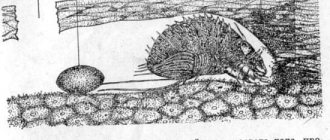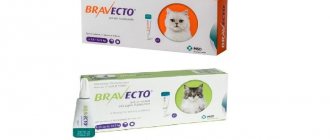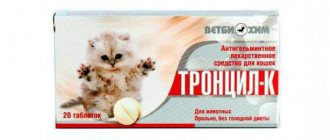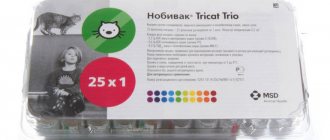Description of the disease sarcoptic mange in cats
Infection
Infection occurs when a pet runs out onto the stairs, encounters an infected animal head-on, or even if it becomes interested in a place where an infected cat is simply lying. He can just sniff it, rub it, and that’s it.
Ticks not only cause great harm, but are also very tenacious. They can live outside the animal's epidermis for up to 8 hours. And infect a healthy cat, literally “jumping” from the infected one.
Attention!
When exposed to frost and “fried” in the sun, ticks quickly die. It is not suggested to keep a cat in extreme temperatures for a certain period of time, of course. But if the cat is overcome by Notoedres (this is the name of one species of Sarcoptidale), then it is more correct to call the disease that, and not saptosis. .
Etiology of appearance. Development of bacteria
A furry friend may return home from the stairs or from a walk already infected.
Important!
At the same time, these diseases are quite difficult to define. The symptoms are very similar to those of a food allergy.
- the cat is itchy;
- redness.
Development of the disease
From there things get even worse. Characteristic bubbles appear near the nose and on the ears, which tend to burst quickly and leave behind scabs.
Those areas that were affected dry out. In scaly areas, the hair tends to fall off.
Ulcers form in place of the scab. Far from attractive, of course. And the cat experiences constant itching. For this reason, he is constantly under nervous stress.
And the worst thing is that this disease also happens to people. There is no need to console yourself with the thought that this cannot happen. Maybe! Only they cannot reproduce on humans. But this does no less harm.
By contacting a sick animal, a person can get pseudoscabies. Its symptoms persist for up to 4 months. Signs of this disease:
- redness;
- itching;
- rash.
https://youtu.be/https://www.youtube.com/watch?v=egMGtyiEAeE
Symptoms of the disease
Infection
Infection occurs when a pet runs out onto the stairs, encounters an infected animal head-on, or even if it becomes interested in a place where an infected cat is simply lying.
He can just sniff it, rub it, and that’s it. The parasites have already “jumped” onto the fur of a previously uninfected animal.
Ticks not only cause great harm, but are also very tenacious. They can live outside the animal's epidermis for up to 8 hours. And infect a healthy cat, literally “jumping” from the infected one.
So, it’s enough to leave your pet’s things (for example, bedding) on the balcony to kill the parasites. Just a couple of hours is enough.
Parasites do not live very long. Total maximum 1.5 months. But they leave behind enormous offspring that live deep in the epidermis.
A furry friend may return home from the stairs or from a walk already infected.
People are unlikely to notice parasites. But it is understandable. They (ticks) strive to get under the skin of their “host” and there start the process of very rapid reproduction. Which, more often than not, they do very well.
- itching;
- The cat's eyes are itchy;
- redness.
Development of the disease
From there things get even worse. Characteristic bubbles appear near the nose and on the ears, which tend to burst quickly and leave behind scabs.
They itch a lot, the cat scratches these places and spreads the parasites throughout its body.
Those areas that were affected dry out. In scaly areas, the hair tends to fall off.
Ulcers form in place of the scab. Far from attractive, of course. And the cat experiences constant itching. For this reason, he is constantly under nervous stress.
The animal loses weight because it does not sleep and eat well. Within a few days, the animal's body is covered with scabs and bald patches. And his open wounds become a breeding ground for new parasites.
And the worst thing is that this disease also happens to people. There is no need to console yourself with the thought that this cannot happen. Maybe! Only they cannot reproduce on humans. But this does no less harm.
By contacting a sick animal, a person can get pseudoscabies. Its symptoms persist for up to 4 months. Signs of this disease:
- redness;
- itching;
- rash.
Sarcoptic mange is called scabies because unbearable itching is one of the main signs of the disease. But a number of other symptoms in cats allow a diagnosis to be made:
- Skin formations appear in the form of bubbles near the nose and ears. The first papules form 10 days after infection.
Papules appear on the face
- After a few days they burst and turn into crusts.
- The animal suffers from severe itching. By scratching the affected areas, the cat spreads the parasite throughout the body.
- Hair falls out in the affected area.
- Ulcers form in place of former papules.
The cat is in a constant state of stress, loses appetite and peace. Regular scratching of wounds often leads to suppuration and even sepsis.
We suggest you read: Scraping for demodex - what it is and how it’s done
An accurate diagnosis is made by a veterinarian, since similar symptoms occur in various dermatitis and allergies. Taking a scraping from the skin, the doctor finds the tick or its eggs, determines the type of parasite and makes a diagnosis. At the same time, a blood test is taken, the animal is checked for fleas and other diagnostics are carried out.
At the first stages, sarcoptic mange in cats has no symptoms. The beginning of the tick's breeding season does not appear in the skin. The first signs of skin lesions usually appear 10-12 days after infection.
Mites reproduce quickly enough, so in just a day the following can be found on the skin under the fur:
- small rash turning into dense bumps and/or blisters;
- scratching turning into extensive ulcers;
- increased peeling of the skin, dandruff, crusts from the dried contents of the blisters, distributed throughout the body;
- obvious severe itching.
Treatment
This disease can be completely cured. This is already making me happy.
Preliminary preparation
First, some veterinarians advise (and do the right thing!). This procedure washes off:
- dead epidermis;
- crusts;
- fallen fur.
If necessary, crusts should be removed with tweezers. This can be done by the owner himself or the veterinarian.
Local treatment
According to reviews, medications that contain selamectin or other insecticides are effective.
The desired form of release is drops. They need to be dripped onto the withers. Treatments must be repeated once every 2 weeks, duration of use is at least 2 months. For the treatment of this type of scabies it is recommended:
- Stronghold (selamectin 6%);
- Advocate (imidacloprid 10% and moxidectin 1%).
Some topical medications can be applied directly to the affected areas of the skin three times (with an interval of 2 weeks between doses):
- Lime sulphide 2-3%;
- Amitraz 0.05%;
- Phosmet 0.09%.
Amidel-gel Neo is an inexpensive and quite effective remedy.
Systemic treatment
Systemic medications should only be used under the supervision of a physician and only after the owner has been explained the likely risks.
An example of such a drug is Ivermectin. The injection is very painful, and the medicine itself is toxic.
Maintenance therapy
The veterinarian can prescribe medications that will restore and protect in the future.
Examples of them are:
- feed sulfur;
- fatty acid;
- other vitamin and mineral supplements.
Sometimes they may be required for animals.
Treatment of sarcoptic mange
Treating sarcoptic mange in a cat, as well as other types of scabies, such as demodectic mange, requires drugs aimed at combating parasites.
We suggest you read: How to quickly get rid of lice at home
At the same time, other animals should not be able to communicate with a sick pet so as not to spread the disease.
This is especially true for dogs, since sarcoptic mites can reproduce not only on cats, but also on them.
Specific medications for this disease are prescribed exclusively by a veterinarian.
The most commonly used medications are Advocate and Stronghold drops, which are applied to the pet's skin.
They are washed off only a month after their effect ends.
This disease can be completely cured. This is already making me happy.
First, some veterinarians advise (and rightly so!) to wash the animal with shampoo. This procedure washes off:
- dead epidermis;
- crusts;
- fallen fur.
If necessary, crusts should be removed with tweezers. This can be done by the owner himself or the veterinarian.
Local treatment
According to reviews, medications that contain selamectin or other insecticides are effective.
The desired form of release is drops. They need to be dripped onto the withers. Treatments must be repeated once every 2 weeks, duration of use is at least 2 months. For the treatment of this type of scabies it is recommended:
- Stronghold (selamectin 6%);
- Advocate (imidacloprid 10% and moxidectin 1%).
Some topical medications can be applied directly to the affected areas of the skin three times (with an interval of 2 weeks between doses):
- Lime sulphide 2-3%;
- Amitraz 0.05%;
- Phosmet 0.09%.
Amidel-gel Neo is an inexpensive and quite effective remedy.
Systemic treatment
Systemic medications should only be used under the supervision of a physician and only after the owner has been explained the likely risks.
An example of such a drug is Ivermectin. The injection is very painful, and the medicine itself is toxic.
The veterinarian can prescribe medications that will restore and protect the animal’s skin in the future.
Examples of them are:
- feed sulfur;
- fatty acid;
- other vitamin and mineral supplements.
Sometimes animals may need sedatives.
The difficulty in treating sarcoptic mange is that it is very difficult to treat the entire cat and it is easy to miss the affected area, which will then again become a source of spread of the mite to other parts of the body.
| Amitrazine, Aversectin ointment | Apply the drug evenly to the affected areas. Apply 2-3 times at intervals of 5 days. |
| Sulfuric ointment | Due to the fact that the ointment has an additional antibacterial and antifungal effect, it is well suited for treatment, because sarcoptic mange is often complicated by purulent dermatitis. One of the most painstaking and cost-effective methods of treatment. Apply daily. |
| Amit | A complex medicine that, in addition to amitrase, also contains antibacterial and anti-inflammatory ingredients. Copes well with the disease and its complications. |
| Aversect (ivomec) 1% solution for injection | It is a very effective remedy because it acts from the inside, but it is better to use it in advanced cases, since ivomec is not as safe as topical drugs. It is administered subcutaneously twice with an interval of 5 days. Dosage: 0.2 ml of the drug per 10 kg of animal weight (200 mcg of active substance per 1 kg of weight). |
| Advocate | Drops on the withers that can destroy subcutaneous mites from the famous German manufacturer Bayer. The easiest and most effective way to get rid of sarcoptic mange. One application to the withers protects the cat from sarcoptic mange for up to 28 days, which is enough for complete healing. This method is the most expensive of those proposed. |
We suggest you read: Oriental tick on cats
Prevention
Curing a disease is not everything. It is necessary to thoroughly clean the apartment so that there is no relapse of the disease.
After 10-12 days, cleaning must be repeated. It is advisable that the pet be removed from the house during cleaning, if possible.
How to prevent a disease such as sarcoptic mange in cats. Follow these simple rules:
- protect him from contact with other cats and dogs, and even more so with other animals;
- with stray animals (this goes without saying);
- wash paws after walking (both dogs and cats, if the owner walks them);
- It is advisable to castrate (cat) or sterilize your pet (cat) so that it simply does not want to run into the street or stairs.
And most importantly, your four-legged friend needs to be kept clean and fed with food that contains useful substances and vitamins.
Sarcoptic mange in cats - symptoms
The first manifestations of the disease appear 10-20 days after infection. The main symptom is pronounced itching, which may intensify in the evening. The first lesions appear on the head. The disease is also accompanied by secondary symptoms:
- the appearance of nodules on the nose, ears and brow ridges;
- the presence of itchy blisters filled with liquid;
- hair loss at the site of scratching;
- the appearance of bleeding scratches;
- hyperpigmentation and thickening of the skin.
A person can become infected with sarcoptic mange from their pet. This happens through direct contact with an animal, or through various household items. In humans, Sarcoptes mites bite into the skin, causing inflammation, which is accompanied by the appearance of papular rashes on the body. The only good thing is that ticks cannot survive on the human body for a long time; they need an animal.
Diagnostics
Diagnosis of this infection is carried out using microscopy methods. In a veterinary clinic, a scraping is taken from the animal. It is taken from the affected areas where symptoms are visible, as well as from healthy but vulnerable areas - elbow bends, stomach, etc. After collecting the sample, it is immediately placed on a sterile glass slide and examined.
During the study, it is possible to determine the presence or absence of eggs, larvae, nymphs or adults of micromites. However, the reliability of such a study is not very high, therefore, carried out once, it cannot serve as a reason to exclude the possibility of infection. The accuracy of this method is only 40-50%. Therefore, if the result of one study is negative, but all the animal’s symptoms are typical and do not decrease, then repeated scrapings are recommended.
Symptoms and diagnosis
Sarcoptic mange in dogs in the first stages of development is localized in the scalp, in the area of the neck folds and on the face. The tips of the ears are also affected.
At this stage, the animal begins to periodically experience itching. Further, itching becomes a constant companion for the animal. In the area of scratching and at the site of skin irritation, the appearance of specific bubbles with liquid is noted. Vesicles filled with a specific exudate burst and dry out. Crusts that appear on the affected skin, as well as dandruff, belong to the second stage.
At the third stage of development of sarcoptic mange, the dog’s hair begins to fall out in place of the crusts. New foci of baldness form. The skin becomes very rough, cracks, hyperpigmentation and keratinization of skin areas appear.
Symptoms of sarcoptic mange that the owner should pay attention to:
- severe itching in the animal;
- anxiety;
- severe scratching on the skin;
- hyperemia and formation of alopecia areas.
To make an accurate diagnosis, it is recommended to contact a veterinary clinic. Differential diagnosis is necessary to detect diseases that have a similar clinical picture to sarcoptic mange.
But the treatment of pathological processes is different. It is necessary to distinguish scabies in a dog from atopic dermatitis, trichophytosis, pyodermatitis, microsporia, ringworm and eczema.
It has been noted that when infected with sarcoptic mange mites, the dog's itching is so severe that it does not go away even after using hormonal-based medications.
To make an accurate diagnosis, scraping from the affected area of skin and further microscopic examination is carried out. During laboratory research, a veterinarian visualizes live ticks in the biomaterial or traces of their recent presence.
Important! Diagnostic scraping to make a correct diagnosis is carried out several times.
If a pet owner suspects a sarcoptic mite infestation in their pet, it is recommended to take appropriate measures. First of all, such an animal is isolated from other household members.
Before showing a sick dog to a veterinarian, it is not recommended to bathe it. Otherwise, the likelihood of detecting a tick in a scraping the first time is reduced significantly.
Therapy
Treatment is carried out with the following drugs according to the following regimens:
- from Bayer are applied to the skin once and protect for 28 days. During this time, recovery occurs and the possibility of re-infection is eliminated;
- Sulfur ointment is applied topically, applied to damaged areas three times a day for five days. Can be replaced with aversectin ointment;
- The complex drug Amit is prescribed by a veterinarian according to an individual regimen for each patient;
- Aversect is an injection administered twice with an interval of 5 days. The dosage is calculated as 0.2 ml per 10 kg of weight.
Using keratolytic shampoos for washing helps relieve symptoms that cause discomfort. It is enough to wash the animal with them once every 2-3 days.
Routes of infection
The source of damage, and subsequently reproduction, most often becomes sick, weakened dogs. Healthy individuals become infected through contact with sick people or through human household items, shoes, clothes, etc. Most often, the disease affects young individuals, who suffer the disease more severely than their adult relatives.
Infection from people who are nonspecific carriers is also possible. In humans, sarcoptic mange is much milder than in animals and manifests itself in the form of redness, followed by a rash and itching, the continuation of these symptoms is possible for up to several months. Sarcoptidale mites cannot live long in the human body, since there are no suitable conditions for the development of their eggs.
Signs
The first days sarcoptic mange is not noticeable, but after 10-14 days the first symptoms appear. On areas of the skin unprotected by hair, so-called pimples (papules) are formed filled with a clear liquid; when they burst, they spread the infection throughout the body. The disease is accompanied by unbearable itching, the infected animal constantly itches, which subsequently leads to the formation of scabs, the animal continues to itch, turning the scales into open wounds and an abscess. If not treated properly and in advanced cases, the disease takes on a chronic head start, which subsequently leads to thickening, pigmentation and even baldness of the skin. The photos clearly demonstrate what the affected areas of the skin look like.
Diagnostics
To make a correct diagnosis, it is necessary to take skin scrapings and obtain an accurate result in the laboratory using microscopy. Despite laboratory tests, no more than 50% of dogs infected with sarcoptic mange receive a positive result. Despite this, preventive treatment is prescribed based on clinical and epidemiological data.
Causes of sarcoptic mange in cats
The causative agents of sarcoptic mange are very small mites, the species of which has the consonant name Sarcoptes.
Despite the fact that they live relatively short (up to several months), during their short life they can give birth to an entire colony of their own kind.
They do this by gnawing tunnels in the animal's skin and laying their eggs there.
Infection with these uninvited guests occurs during contact with an already sick animal or objects they touched.
If a cat touched a fellow cat with sarcoptic mange and studied a toy he had forgotten, trying to understand what it was, then she is at high risk of contracting this disease as well.
Important! A characteristic feature of this type of tick is the ability to remain outside the body, on which it can be parasitized for up to 8 hours. But in the sun or frost they die within two hours.
This can be used to clean a sick cat's belongings. For example, take his bedding, bowl and other things outside for a specified time during frosty or sunny weather. This way you can get rid of annoying parasites on these items.
On human skin, mites that cause sarcoptic mange quickly die and are not able to develop.
However, they can cause temporary redness of the skin, itching and an allergic reaction.
Treatment
Treatment of sarcoptic mange in dogs includes several stages. To begin, the pet must be washed with a soapy solution using antiseborrheic agents. After which the animal is treated with acaricide preparations at intervals of several weeks. Dicresil, karbofos, and an aqueous solution of diazinon show good results in the fight against ticks. Macrolide drugs are administered subcutaneously or intramuscularly, the dose is 0.1 ml/kg per dog’s body weight, applied twice with an interval of 7-9 days. Externally they use products containing selamectin, which has long been used to treat sarcoptic mange in many countries.
The disease is treated well with systemic agents such as brovermectin granules and ivermectin. However, these drugs should not be prescribed to breeds such as sheltie, coli, and bobtail; they have severe side effects. Therefore, ointments are made based on these drugs, which are then rubbed into damaged areas of the skin. Treatment is necessarily accompanied by the use of a muzzle in order to avoid licking of drugs and poisoning of the pet. For the fastest restoration of fur, sulfur-containing preparations are recommended.
Development of the disease in cats
Signs of illness
Symptoms of sarcoptic mange appear in cats, as in dogs, affecting the skin. In the area of the head, on the ears, nose, and near the eyebrows, vesicles and pustules filled with liquid appear, which cause constant itching, leading to the formation of scabs, scratching the skin until it bleeds. In these places, hair falls out, and the skin becomes rough and begins to crack. The photo on the Internet shows what the affected area of the skin of a sick animal looks like.
Important! Try to ensure that your pets do not “communicate” with “vagrants” when walking, and do not eat in garbage dumps. Then you will have peace of mind for their health, and in some cases, for your own.
Diagnosis is based on a clinical examination of the pet by a veterinarian and through laboratory tests, for which it is necessary to take a skin scraping in the affected area and study it under a microscope.
Therapy
A sick pet must be isolated from other animals and its contact with other family members must be minimized. One of the most effective, although expensive, methods of treatment are drops on the withers Advocate of the German company Bayer. A one-time application protects the animal from sarcoptic mange for up to 28 days, which is enough for a complete recovery. The use of sulfur and aversectin ointments gives positive results in the fight against the disease. They should be used several times a day for 5 days. The complex remedy Amit, containing anti-inflammatory and antibacterial substances, copes well with infection.
In more severe cases, it is possible to use drugs that are administered subcutaneously; they act quickly and effectively due to the fact that they act from the inside. One of these is aversect, applied at the rate of 0.2 ml per 10 kg of weight twice with an interval of 5 days. Bathing with keratolytic shampoos also gives a good result in the fight against scabies. It is necessary to put a funnel on the treated animal to avoid licking and poisoning of the pet. In parallel with treatment, the room where the infected animal is kept should be disinfected.
Treatment of sarcoptic mange in cats
If a cat is sick with sarcoptic mange, the hair should be cut off in all places where the microscopic pest is parasitizing. This must be done, because if you miss the source of parasitism, the skin will become infected in the second round. After this, you need to soak all the crusts with a weak raster of Furacilin so that they do not absorb the main medicine.
Amitrazine is effective in therapy . These are drops based on rapeseed oil. It is this component that allows the drug to be absorbed as much as possible. Before treating the skin, we recommend taking measures to prevent the cat from licking the medicine - you can use a collar for this. The affected areas should be treated and the healthy skin should be grabbed approximately two centimeters around to prevent the migration of the tick. You can’t smear it every day; manipulations are done every three days. After signs of infection disappear, one or two additional treatments should be performed. As a rule, up to 7 treatments are required for recovery. After the medicine is applied, hold the cat's face for 20 minutes to prevent him from licking the substance.
"Demos" is a sulfur-based anti-tick ointment. As you know, sulfur is very effective against skin mites and destroys their eggs. It can also be used for demodicosis. The ointment has a rather thick consistency, but upon contact with the body it becomes soft and absorbs well. The use is the same as the previous drug: apply a thin layer of ointment to cleansed skin, be sure to treat the skin around the passages and monitor the animal for half an hour to prevent licking. Process once a week for 3-4 weeks. If the cat becomes irritated by the ointment, rinse the area thoroughly and stop further use of the drug.
You can also use regular sulfur ointment. It is effective in the fight against ticks.
"Ivermek-gel" . An effective remedy that affects ticks and larvae by paralyzing them. The gel contains panthenol, due to which faster healing of inflamed skin occurs; lidocaine has an analgesic effect, and the medicine also relieves itching. Treatment should be done according to the scheme described above twice a day with a break of a week. The full therapeutic effect is achieved after 3-5 treatments. The maximum amount of use of the product is 6 times. Precautionary measures: if you have a predisposition to contact allergies, do not allow the product to come into contact with your skin.
The most effective treatment for sarcoptic mange in cats is drops on the withers. They have a fairly strong therapeutic effect, and their use eliminates the possibility of licking the medicine. Effective anti-tick remedies include:
- "Advocate" . Drops are applied to the cat's withers in the amount required by its weight. If the cat weighs 2-4 kg, apply 0.4 ml of “Lawyer”. Weight up to 8 kg - 0.8 ml. Do not drop into the ears; the product is intended for external use only. There are contraindications for kittens up to 9 weeks. If your pet weighs up to a kilogram, use is carried out in a lower dosage and under the supervision of a specialist. You cannot use several drugs with similar effects at the same time.
- "Stronghold" . The dosage is calculated from the following indicators: for a cat weighing up to two and a half kg, the permissible dose of the medicine is 0.25 ml. Up to 7.5 kg - 0.75 ml. Up to 10 kg - 1 ml. All dosage information is indicated on the drops packaging. They are applied once a month.
- "Dironet."
- "Helminthal K".
Leakage in pigs
Sarcoptic mange in pigs is caused by the Sarkoptessuis mite, which infects the epidermal layers of the skin, most often in the areas where the hairs emerge, where the skin is thinnest. Animals constantly scratch, tearing the skin until it bleeds, thereby provoking the formation of scabs. The photo in the medical literature shows what infested pigs look like.
The disease most often affects young individuals under one year old, with not yet strengthened immunity. If the disease is not treated, then upon reaching six months of age the disease enters the chronic stage. In adults, infestation is noticeable upon closer inspection.
Despite the pronounced signs of sarcoptic mange, in order to obtain the correct conclusion, the skin of affected pigs is scraped until blood appears for diagnosis.
Therapy
Treatment for sarcoptic mange in pigs should begin with softening and removing hardened parts of the body. After which the young animals are bathed, and the adults are sprayed with such agents as 2% SK-9 emulsion, 2% chlorophos solution, TAP-85 preparation, 1% creolin soap solution, 1.5% trichlorometaphos. When treating animals with liquid solutions, the inner surface of the ears should be carefully treated. Animals are injected intramuscularly with the drug Ivermek, and Novomek 1% is injected subcutaneously at the rate of 1.5 ml per 50 kg, twice with an interval of up to 10 days. To disinfect premises and paddocks where sick animals are kept, the same preparations should be used as for spraying pigs.
Note! The information about treatment on this site is provided for informational purposes only; only a veterinarian can determine the correct diagnosis and prescribe medications.
Consumption of meat from processed animals is permitted no earlier than 10 days after the last spraying with chlorophos, trichlorometaphos-3 after 45 days, and only two months after the use of creolin and TAP-85.
For preventive purposes, sanitary requirements should be observed, livestock should be periodically inspected, and contact of sick animals with healthy ones should be prevented. New animals entering the farm should be quarantined for 30 days and treated with acaricidal agents for preventative purposes.
source
Sarcoptic mange not only causes a certain discomfort and real physical suffering to the pet, but also significantly spoils the appearance of the animal, worsening the condition of the skin and ruffled fur. The cat becomes irritable with sudden bouts of aggressiveness due to unbearable, constant itching.
At the first stages, sarcoptic mange in cats has no symptoms. The beginning of the tick's breeding season does not appear in the skin. The first signs of skin lesions usually appear 10-12 days after infection.
Mites reproduce quickly enough, so in just a day the following can be found on the skin under the fur:
- small rash turning into dense bumps and/or blisters;
- scratching turning into extensive ulcers;
- increased peeling of the skin, dandruff, crusts from the dried contents of the blisters, distributed throughout the body;
- obvious severe itching.
The main places of localization of skin manifestations:
- collar area (neck and withers);
- areas of skin along the spine;
- area around the tail;
- occasionally - the inner surface of the thighs;
- in the generalized form, the head may be affected - the brow ridges, cheeks, beard, ears, crown.
In addition to local manifestations, sarcoptic mange in cats is accompanied by general symptoms of malaise:
- lethargy, apathy, drowsiness;
- sudden sharp movements, jumping, meowing (a sign of unbearable itching);
- tousled hair falling out in clumps in areas where scratching and rashes occur;
- increased hair loss over the entire surface of the body;
- noticeable weight loss;
- In affected areas, the skin may change color (darken) and thicken.
What is sarcoptic mange and how does infection occur?
Sarcoptic mange in dogs is caused by a microscopic subcutaneous mite of the genus Sarcoptes . The causative agent of a parasitic disease is widespread on the European continent. Female parasites are slightly larger than males. Males are no more than 0.2 mm in size, and females are no more than 0.5 mm in size.
The tick's body is oval in shape and pale gray in color. On the dorsal part there are specific scales in the form of triangles. They have short and thickened legs equipped with suction cups.
The average lifespan of a sarcoptic mite is no more than 2 weeks. During this period of time, fertilized females lay about 50 eggs.
As a rule, ticks of the genus Sarcoptes primarily infect domestic animals. But cases of detection of subcutaneous microscopic mites in humans, transmitted from dogs, have been described. In humans, the disease is called pseudosarcoptosis.
Parasites have a well-developed oral apparatus, allowing them to gnaw passages under the skin and penetrate into the deeper layers. Ticks gnaw tunnels in different directions, which causes severe itching in the dog. Ticks are especially active at night. The dog does not sleep well, itches constantly and may whine.
As a result of mechanical damage (parasites gnawing passages), tissue structures become inflamed. A specific exudate, serous type, is released. As a result of inflammation, blisters or vesicles are diagnosed on the surface of the skin. Severe itching in an infected animal occurs as a result of irritation of nerve fibers. Itchy sensations provoke scratching. Against the background of sarcoptic mange, secondary infection with pathogenic bacterial microflora often occurs.
As the bubbles containing the exudate rupture and then dry out, crusts form on the skin. The stratum corneum layer of the skin thickens when soaked in a specific liquid. The skin loses its elasticity, folds and cracks form. In place of the most damaged areas, hair falls out and areas of alopecia form.
A healthy dog can become infected from a sick animal. Infection can occur through the use of contaminated animal care items, clothing or bowls. But in the vast majority of cases, the main route of infection is direct contact of a sick animal with a healthy one.
How and with what to treat
Only a veterinarian can tell you how to treat sarcoptic mange in cats. Therapeutic procedures include not only external treatments, but also injections and sometimes oral medications (given by mouth).
- First of all, before starting treatment, it is ideal to trim the animal, especially in places where there are scratches, scabs, wounds, etc., i.e. signs of tick activity.
- After grooming, the animal must be bathed using any keratolytic shampoo (for example, TM Doctor, Nizoral or ordinary tar soap) to gently remove crusts and scabs. It’s good if the shampoo contains an antimicrobial and antifungal component. It is important to soak all the crusts so that during the removal process there is no ichor and the wound surface does not increase.
The course of injectable anti-tick drugs is calculated:
| Doramectin | Intramuscularly at a rate of 0.6 mg/kg once a week. It takes 2 injections with an interval of 5-8 days. |
| Ivermectin | Subcutaneously or intramuscularly for adult cats at a dose of 0.75 mg/kg, for kittens – 0.11 mg/kg. It is better to dose using an insulin syringe. In the normal course of the disease, 2-4 injections with an interval of 7 days are sufficient. |
| Aversect K&S (aversectin) | 0.1 ml of 0.2% solution for each kg of body weight into the muscle or under the skin. The interval between injections is 7-10 days. Usually 2 injections are enough, subject to complex treatment with local treatment of the affected areas. |
Anti-tick tablets:
Hepatoprotectors
With long-term use of specific anti-tick drugs - either in tablets or injections - hepatoprotectors may be needed to maintain liver function:
Is feline sarcoptic mange transmitted to humans?
How long does it take to treat mite-borne (pruritic) scabies?
Can sarcoptic mange in cats be cured at home?
The problem with the pathology is that the affected skin becomes an excellent breeding ground for additional bacterial (purulent) and/or fungal infections. What, in fact, happens most often is that various types of dermatitis develop. During the treatment of pruritic scabies, it is often necessary to resort to additional antimicrobial and antifungal treatments not only externally, but also to ingestion of appropriate drugs. The drug burden on the body increases. In addition, the risks of developing allergic reactions to waste products of ticks and their larvae are growing.
There is no need to console yourself with the thought that sarcoptic mange does not occur in people. Yes, Sarcoptes mites, having transferred to human skin, cannot reproduce, since this is the epidermis of a non-specific “host”. Simply put, they die on the human body. However, when in contact with a sick animal, the owner of a furry pet runs the risk of getting pseudo-scabies, the symptoms of which persist for up to 4 months: redness, rash, itching. Children may develop allergies after contact with an affected cat.
Sarcoptic mange in cats: symptoms and treatment | photo
Sarcoptic mange is a disease caused by the itch mite. It causes a lot of discomfort in cats and can spread to humans. The owner can determine the disease independently based on characteristic signs. What are the main symptoms and treatments for sarcoptic mange?
The causative agent of the disease
Sarcoptic mange is caused by mites of the genus Sarcoptes. It is noteworthy that the disease affects different animals, but the ticks are also different. A person also becomes infected, but such a tick does not multiply in his body, dies, and the disease goes away on its own. The parasite feels great in the cat’s body, digs holes in the deep layers of the skin and causes significant suffering.
A pet becomes infected from sick animals or household items. One meeting with a carrier, such as an outdoor cat, is enough, and the indoor cat will also develop sarcoptic mange.
Once in a new organism, the tick lays eggs, which degenerate into an adult in 21 days.
The mite is half a millimeter in size and lives from 4 to 6 weeks, during which time it manages to produce huge offspring, which in turn also lay eggs.
If for some reason the arthropod leaves the host’s body, then it is able to survive in the environment for another 2 weeks, even at zero temperatures, and its eggs remain viable for a month.
Symptoms of the disease
Sarcoptic mange is called scabies because unbearable itching is one of the main signs of the disease. But a number of other symptoms in cats allow a diagnosis to be made:
- Skin formations appear in the form of bubbles near the nose and ears. The first papules form 10 days after infection.
Papules appear on the face
- After a few days they burst and turn into crusts.
- The animal suffers from severe itching. By scratching the affected areas, the cat spreads the parasite throughout the body.
- Hair falls out in the affected area.
- Ulcers form in place of former papules.
The cat is in a constant state of stress, loses appetite and peace. Regular scratching of wounds often leads to suppuration and even sepsis.
An accurate diagnosis is made by a veterinarian, since similar symptoms occur in various dermatitis and allergies. Taking a scraping from the skin, the doctor finds the tick or its eggs, determines the type of parasite and makes a diagnosis. At the same time, a blood test is taken, the animal is checked for fleas and other diagnostics are carried out.
How to help
Treatment of sarcoptic mange in cats is a labor-intensive process. It is necessary to treat the entire animal and not miss the affected area, otherwise it will cause further spread of the parasite.
Important! The drugs do not affect parasite eggs. It is necessary to treat your pet's skin in such a way as to destroy new mites before they lay eggs again.
There are several drugs and treatment regimens for the disease:
- Amitrazine. The product must be applied to each affected area, without missing a single lesion. This is done with a cotton swab, extending 1-2 centimeters beyond the boundaries of the lesion. It is important to ensure that the cat does not lick the medicine during the 20 minutes during which it is absorbed. The procedure is repeated 5-7 times every 3 days. The drug does not cause adverse reactions, but it should not be used in pregnant cats and kittens under 2 months of age. In addition, do not use the product if you have an individual intolerance to the components. Breeders note the high effectiveness of the drug. The animal feels relief the very next day.
- Sulfuric ointment. The animal is treated for several days, and then interrupted for a day. The course lasts from 7 to 20 days. The method is very labor-intensive, but has advantages: having antibacterial and antifungal properties, it also eliminates suppuration, which often occurs due to scratching itchy areas. For the treatment to be effective, the cat is put on a special collar to prevent licking of the ointment. If the inflammation is not severe, then the ointment is applied and rubbed in, but in case of more serious lesions and fluid is released, it is better to put a bandage on the ointment and stick it with a band-aid, and do not rub the ointment. The drug has no contraindications and is used not only in cats, but also in dogs and livestock.
- Amit. It affects the tick and related complications, thanks to its antibacterial properties and the ability to remove inflammation. Thanks to the active substances, the parasite is first paralyzed and then dies. The substances do not pose a danger to the animal; they do not penetrate the blood and act locally. First, the skin is cleaned of scabs, and then the drug is applied. This is how the affected areas are treated twice, interrupting for 7-10 days. The product should not come into contact with mucous membranes, and should be applied with gloves. In addition, you should not allow small children to pet the animal during the first 24 hours. The drug should not be used in kittens and weakened, pregnant cats. In addition, there are other contraindications, such as allergies to components and some infections.
- Aversect. It is introduced into the body in the form of subcutaneous injections. The method is not as safe as external exposure, but it helps to cope with the disease in advanced cases. Administer twice, maintaining an interval of 5 days. The drug must be administered by a veterinarian who will correctly calculate the dosage. It is prohibited to use the drug on weakened and pregnant animals.
- Lawyer from Bayer. These are drops that are applied to the withers. The skin should be dry and undamaged. The dosage depends on the body weight of the animal. General precautions should be observed when using drops: do not allow them to come into contact with mucous membranes, ensure that the animal does not lick the drug and do not allow contact between the cat and small children for 24 hours after applying the product. This is a costly method of treating sarcoptic mange in cats, but it is simple and effective. The animal is protected from the parasite for a month. This period is most often enough to completely get rid of the disease.
Sarcoptic mange in cats: symptoms (photos) and treatment
All of the above indicates only one thing - therapy for such a disease should be started as quickly as possible. This disease develops rapidly, takes a long time to treat and is extremely undesirable for pet owners. At the first signs of illness, your cat should be seen by a doctor! Diagnosing sarcoptic mange in cats and prescribing appropriate treatment on your own is extremely difficult. Its symptoms are similar to other diseases, and an accurate diagnosis can be made only by scraping the skin, which involves laboratory examination of a pustule - an element of the rash that has purulent contents. Having differentiated bites from Notoedres ticks, the doctor will prescribe appropriate treatment.
The affected areas dry out, hair falls off in itchy areas, and scabs form extremely unattractive ulcers. Source: Flickr (notoedroz2)
Diagnosis of sarcoptic mange in cats
Since the symptoms are very similar to purulent dermatitis, lichen and flea bites, these diseases must be excluded. Also, pinpoint lesions may be similar to allergic dermatitis. Sarcoptic mange differs from another type of scabies, notoedrosis, in that it affects the entire body, not just the head and neck. For an accurate diagnosis, it is necessary to examine scrapings from the affected areas under a microscope. This will also help eliminate a more dangerous parasitic disease of cats - demodicosis, which can be treated according to a different scheme.
Photos of cats affected by sarcoptic mange:
Sarcoptic mange on the abdomen. Similar to allergic dermatitis.
Scratching for sarcoptic mange
Yellow crusts with sarcoptic mange
Skin with chronic sarcoptic mange
How to treat sarcoptic mange in cats: drops and ointments
“Stronghold” is dripped onto the animal’s withers in an amount that is suitable for a particular cat (depending on its weight). The dosage is indicated in the instructions for use of the drug, but first you need to check with your veterinarian.
Along with the drops, the specialist prescribes how to treat sarcoptic mange in cats (drops, ointments and other remedies).
The action of preparations for treating the skin of an animal is aimed at normalizing the functions of the epidermis, fighting against signs of alopecia, and improving the immune system. They are rubbed into the pet’s skin, and the treatment must be carried out several times a day for a certain period of time (from 4 days to a week).
Symptoms of sarcoptic mange in cats
Sarcoptic mange affects domestic cats in the muzzle area. The area of the forehead and wings of the nose is affected. In the absence of treatment, scabies leads to damage to the entire body of the animal. Damage to the skin in advanced forms provokes a number of dangerous lesions. Sarcoptic mange leads to disruption of the nervous system, affecting the functioning of the heart and blood vessels. Against the background of scabies, the cat's protective barrier is reduced, so the body is more often susceptible to various infectious diseases.
Depending on the severity of the pathological process, sarcoptic mange differs in symptoms. The main signs of the development of scabies in a cat, provoked by the activity of microscopic subcutaneous mites, are:
- red spots on the skin that appear at the site of mite penetration, mild itching;
- the appearance of small blistering rashes - occurs 5-7 days after the tick has been introduced (when the blisters burst, exudate comes out of them, dries out and forms crusts and scabs on the skin);
- severe itching, causing scratching all over the body (at the same time, parasites are spread throughout the body);
- the formation of areas of alopecia, the skin affected by mites quickly dries out;
- the occurrence of ulcerative lesions, erosions and cracks in the skin, causing severe discomfort in the animal, as a result of which the pet loses its appetite, sometimes completely refusing food, and losing weight;
- the introduction of pathogenic microflora into cracks and ulcers during sarcoptic mange, which leads to serious damage to the skin, if left untreated, leading to blood poisoning and death.
Sarcoptic mange can provoke the development of allergic reactions to the waste products of parasites. In some cases, dandruff may appear. Lack of therapy leads to the development of a chronic form of the disease.
It is quite difficult to understand that your pet has been infected by a scabies mite. Signs of the disease can be easily confused with allergies, pyoderma, and demodicosis. If you suspect your pet has scabies mites, you should seek help from a veterinarian. The specialist will prescribe a number of laboratory and instrumental tests to make an accurate diagnosis.
Diagnosis includes a general clinical examination, as well as skin scrapings for microscopic examination. Based on the data obtained, the specialist develops an individual treatment strategy. The cat is prescribed specific drugs and medications for general restoration of the body.
Disease prevention
Floors are washed with disinfectants that are guaranteed to kill ticks. Everything that the infected person has come into contact with must be thoroughly treated.
Note! When cleaning, the pet should be removed from the house so that the disinfectant does not get on its paws or fur, which it will certainly begin to lick. Some products are effective (for example, Lysol or Creolin), but extremely poisonous!
After cleaning, the room should be ventilated and the surfaces should be rinsed again, but with plain water. After 10-12 days, cleaning should be repeated.
How to prevent such an unpleasant disease as sarcoptic mange in cats? Treating it will require some patience from the owners. Some pets get nervous when a special collar is put on them. And it will definitely be required so that the animal does not have the opportunity to lick the skin treated with drugs. It is much easier to prevent your cat from getting sick, which means you need to:
- protect him from contact with stray animals;
- wash paws after walking;
- It is advisable to castrate (cat) or sterilize your pet (cat) so that it does not have impulses to run out into the street or landing.
And most importantly, your four-legged friend needs to be kept clean and fed with food that contains useful substances and vitamins. Statistics show that cats with weak immune systems fall ill most quickly. Remember that the health of your furry pet depends only on you!











